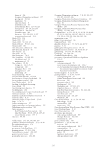Lake Eyre Basin Rivers 128 and sheep production, benefiting from the widespread and variable floods and a reasonably reliable annual rainfall of 350–450 mm. The flooding was essential, providing the soil moisture for pasture growth, which lasted for up to two years. For example, native millet (Panicum decompositum) produces dry matter yields of up to 5 t/ha after a flood (Queensland Department of Primary Industries and Fisheries 2007). The river system The flow of the Balonne River is incredibly variable, with an average flow at St George of ~1.2 million ML/year before it was developed. More than 51% of this annual water volume between 1920 and 2013 was in just 20% of years. In the other 80% of years, the average flow was about half the average volume, with 30% of the total volume passing St George in this period occurring in just five events: 1950, 1956, 1976, 1983 and 2011. The highest annual flow at St George was 800% greater than the average annual flow, considerably more variable than the River Murray. Before water resource development upstream of our property of Bullabellalie (Fig. 14.1), floods came and went, extending our pasture growth through the dry times. The scale of our productivity went up with increasing volume, height and duration of flooding, which was also dependent on antecedent conditions and upstream catchment conditions. Even when we did not have rainfall, the floods came and benefited us. For example, heavy local rainfall (200–300 mm over two days) ~160 km upstream in 1981 produced a small flood on our station, Bullabellalie. This event was critical for us, allowing my family to retain 250 core breeding cows for another three months, until it rained. Without the flood, we would have incurred an opportunity cost of about $250 000. This would have included selling cows onto a depressed market and the cost of later needing to replace them. Floods mean money to many of us who produce livestock from the floodplains of rivers (see Chapter 11). It is not just the people of the floodplains who benefit from the rivers. The local towns of Dirranbandi, Hebel, Angledool, Goodooga, Weilmoringle and Brewarrina (Fig. 14.1) have also prospered since 1860, with the production from the healthy rivers and floodplains of the Lower Balonne. This all changed with irrigation development upstream of the Lower Balonne in the Condamine–Balonne catchment of the Murray–Darling Basin. The age of development The Condamine–Balonne river catchment was the last major river in the Murray–Darling Basin to be developed for its water resources (Kingsford 2000a Thoms 2003 Kingsford 2004) and the environmental and social consequences are all too apparent. Development started in the Lower Balonne when the first broad-scale irrigated cotton was grown in 1972, after Beardmore Dam at St George was finished, storing 81 000 ML (Fig. 14.1). This was beginning of the end for the health of the rivers, starting the first major reduction in the volume, extent and duration of the flooding in the Lower Balonne system. Initially, the irrigation scheme struggled, as farmers tried different crops and experimented with which seasons to plant in. Agronomy, technology and skills improved, particularly for the cultivation of irrigated cotton. There was a strong social drive, backed by the mantra to diversify, which beckoned struggling grazing enterprises. Concerted water resource
Downloaded from CSIRO with access from at 216.73.216.88 on Nov 13, 2025, 2:31 AM. (c) CSIRO Publishing

















































































































































































































































































